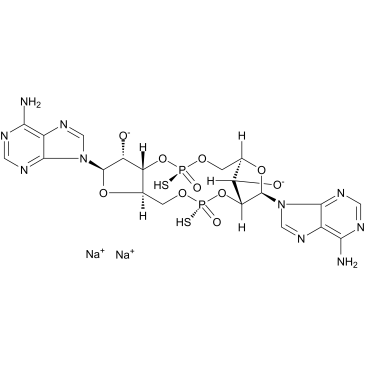ADU-S100 disodium salt (Synonyms: MIW815 disodium salt; ML RR-S2 CDA disodium salt) |
| Catalog No.GC39161 |
La sal disÓdica ADU-S100 (sal disÓdica MIW815) es un activador del estimulador de genes de interferÓn (STING).
Products are for research use only. Not for human use. We do not sell to patients.

Cas No.: 1638750-95-4
Sample solution is provided at 25 µL, 10mM.
ADU-S100 disodium salt (MIW815 disodium salt) is an activator of stimulatory interferon gene (STING) protein with a Kd of 4.61±0.42μM[1]. The mechanism of action of ADU-S100 disodium salt is to activate the STING pathway by simulating the effect of cyclic GMP-AMP (cGAMP), thereby inducing the production of inflammatory cytokines such as IFN-β[2]. ADU-S100 disodium salt shows higher anti-tumor ability than endogenous ML cGAMP [3].
In vitro, ADU-S100 disodium salt (0-100µM) treated glioblastoma (GBM) cells without toxicity, but in the presence of PBMC, ADU-S100 produced immune-mediated cytotoxicity against GBM cells at 12.5 and It is effective between 50µM and less effective at 100µM[4]. ADU-S100 disodium salt stimulated the THP-1 Dual cell line for 48 hours, and the EC50 values of activated cell IRF 3 and NF-κB pathways were 3.031 and 4.839µg/mL respectively [5].
In vivo, ADU-S100 disodium salt (50µg) was administered via intracranial injection to GL 261 and CT-2A tumor model mice 3 days after treatment, causing suppression of microglia and T cell populations, as well as NK and inflammatory responses. In the infiltration of immune cells, the proportion of T cells recovered 7 days after treatment and increased compared with the baseline level [4]. ADU-S100 disodium salt (20 or 40µg) was treated by subcutaneous injection in colon cancer model mice, which effectively inhibited the growth of CT-26 tumors, significantly increased the number of lymphocytes, and prevented tumor metastasis to liver and spleen tissues[6].
References:
[1]Jekle A, Thatikonda S, Stevens S, et al. Abstract 4520: Preclinical characterization of ALG-031048, a novel STING agonist with potent anti-tumor activity in mice[C]//Proceedings: AACR Annual Meeting 2020; April 27-28, 2020 and June 22-24.
[2]Jneid B, Bochnakian A, Hoffmann C, et al. Selective STING stimulation in dendritic cells primes antitumor T cell responses[J]. Science Immunology, 2023, 8(79): eabn6612.
[3]Corrales L, et al. Direct Activation of STING in the Tumor Microenvironment Leads to Potent and Systemic Tumor Regression and Immunity[J]. Cell Rep. 2015 May 19;11(7):1018-30.
[4]Berger G, Knelson E H, Jimenez-Macias J L, et al. STING activation promotes robust immune response and NK cell–mediated tumor regression in glioblastoma models[J]. Proceedings of the National Academy of Sciences, 2022, 119(28): e2111003119.
[5]Ji N, Wang M, Tan C. Liposomal delivery of MIW815 (ADU-S100) for potentiated STING activation[J]. Pharmaceutics, 2023, 15(2): 638.
[6]Zaidi A H, Kelly R J, Gorbunova A, et al. Intratumoral immunotherapy with STING agonist, ADU-S100, induces CD8+ T-cell mediated anti-tumor immunity in an esophageal adenocarcinoma model[J]. Oncotarget, 2021, 12(4): 292.
Average Rating: 5 (Based on Reviews and 22 reference(s) in Google Scholar.)
GLPBIO products are for RESEARCH USE ONLY. Please make sure your review or question is research based.
Required fields are marked with *




















